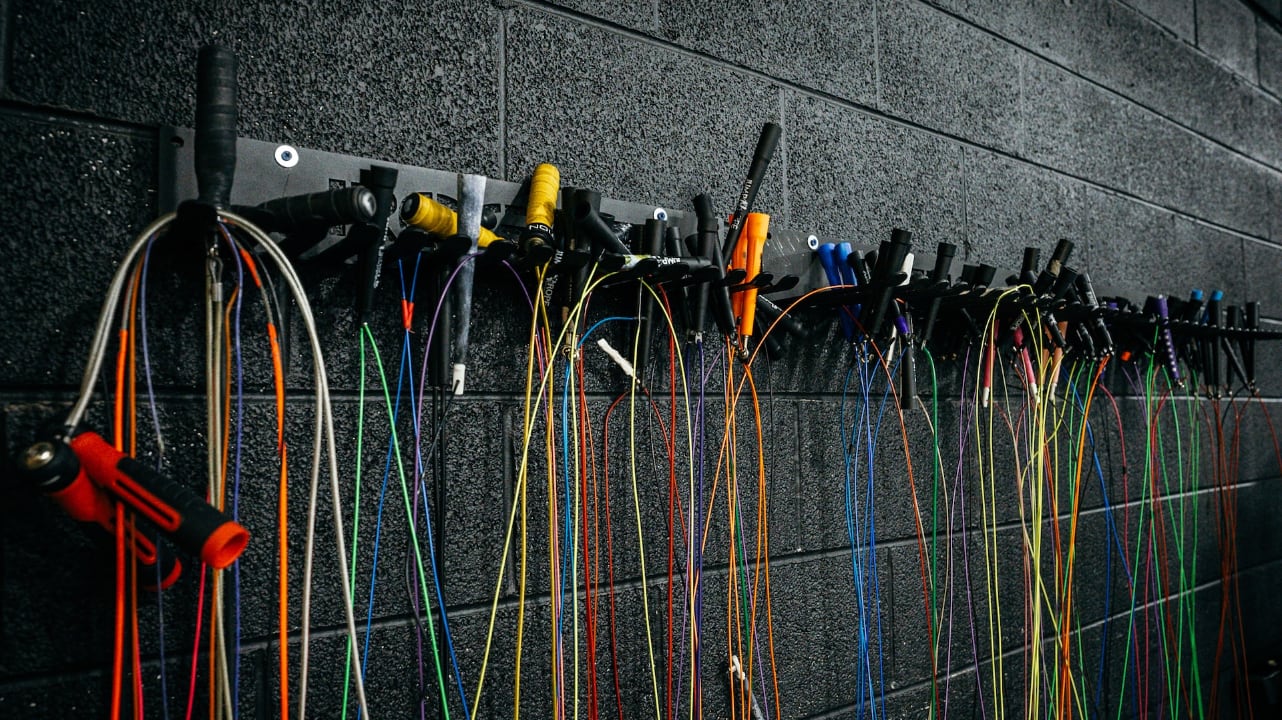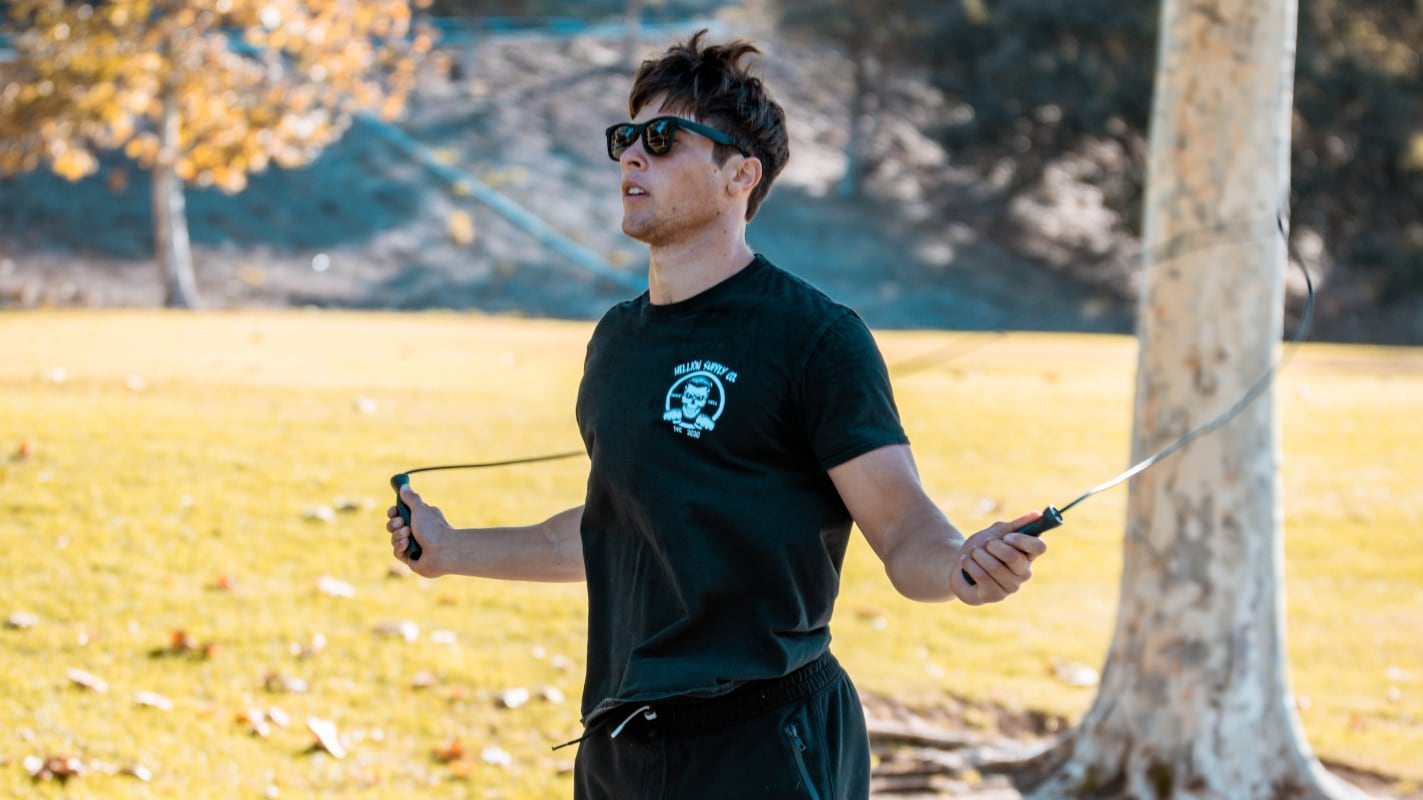Updated October 21, 2023
Double-unders are among the most challenging yet rewarding CrossFit skills you can learn. Not only do they provide an intense cardio workout, but mastering double-unders also requires coordination, timing, and practice. If you’ve struggled to string together more than a few revolutions of the rope or want to take your double-under game to the next level, this guide is for you.
What Are Double-Unders and Why Do Them?
Double-unders are a jump rope skill where the rope passes under your feet twice for every jump. They require precise timing and coordination to execute correctly. Double-unders provide a fantastic cardio workout that torches calories and works your entire body.
Some of the main benefits of double-unders include:
- Intense calorie burn. Double-unders can burn over 1,000 calories per hour, which is more than running at a 6 mph pace.
- Full-body workout. Double-unders work your core, legs, glutes, shoulders, and arms.
- Improved coordination and footwork. Mastering the timing and rhythm of double-unders helps enhance your coordination, agility, and foot speed.
- They can be done anywhere. All you need is a jump rope, so double-unders are a convenient exercise you can do at home, while traveling, or anywhere else.
- Progressive skill. Stringing more and more double-unders together builds up your endurance and speed. This allows for constant improvement and progress.
If you want to improve your cardio fitness, athleticism, and jump rope skills, double-unders are the way to go. Let’s move on to selecting the proper jump rope for double-unders.
Select the Right Jump Rope

Having the proper jump rope is essential for learning and mastering double-unders. Here are some tips for choosing a high-quality double-under jump rope:
- Get a rope specifically designed for double-unders. A standard jump rope won’t spin fast enough or have the correct weight distribution for double-unders. Look for a rope labeled as a “double-under rope” or “CrossFit speed rope”.
- Choose the correct rope length. A good rule of thumb is when you stand on the rope with one foot, the bottom of the handles should be at your armpits. This will roughly equate to your height plus 3 feet.
- Start with a slightly heavier rope. As a beginner, a slightly heavier rope (3 to 4 ounces) will provide more feedback, allowing you to “feel” where the rope is in its rotation. This will be easier to spin and control as you learn proper technique and timing.
- Consider a rope with ball bearings. Ropes with ball bearings in the handles help the rope spin faster and smoother, which is helpful for double-unders. However, a bearing-less rope will still work fine and may be more cost-effective when first learning.
With the right rope selected, you’ll have the proper tool to start practicing double-unders. Next, we’ll cover the basic jumping technique to build a solid foundation.
Build Explosiveness
To perform double-unders, you must jump high and fast enough for the rope to spin twice before landing. Some exercises that can help build explosiveness and improve your double-under form include:
- Power jumps. Stand with feet shoulder-width apart and bend your knees. Jump up as high as possible, reaching your arms overhead and straightening your legs. Land softly on the balls of your feet. Do 2-3 sets of 10-20 power jumps 2-3 times a week.
- High knee running in place. Run in place, lifting your knees as high as possible on each step. Swing your arms for momentum. Do 2-3 minutes of high knee running in place 2-3 times a week. This helps strengthen your core and hip flexors for an explosive jump.
In addition to these exercises, be sure to warm up your muscles before practicing double-unders. Staying flexible and explosive will allow you to jump higher and spin the rope faster.
Master the Basic Jump
Before attempting double-unders, it’s essential to master the basic jump. Practice the following techniques without a rope first to get comfortable:
- Jump in place. Start by jumping in place, landing softly on the balls of your feet. Keep your core engaged, and don’t lock your knees. Practice jumping higher than you normally would for regular, single-under jumps.
- Practice the swing. Put your jump rope away and practice spinning your hands/wrists in circles (as if you were holding the rope handles) while jumping in place. Focus on finding a rhythm and speed that allows you to consistently get a double swing rotation for each jump.
Once you are comfortable with the higher jump while spinning your hands/wrists for 10 reps each time, it’s time to do it for real. Hold the handles and start spinning the rope while jumping. The key is to start slowly and be patient with yourself as you learn to time your jump with the rope.
Put It All Together: Your First Double-Under

Now that you’ve built some explosiveness and mastered the basic jump, it’s time to put it all together for your first double-under. Follow these steps:
- Start with higher jump single-unders. Hold the handles of your jump rope and start by doing single-unders but with a higher jump. Land softly on the balls of your feet.
- Now add in a double-under. As soon as you land a few single-under jumps, keep going, but spin the rope twice in quick succession on your next jump. This is your first double-under!
- Be patient and keep practicing. It can take time and many attempts for everything to click into place. Don’t get frustrated if the rope hits your feet and legs or you struggle with timing at first. With regular practice, your double-under skills will improve.
- Focus on a consistent rhythm. Work on spinning the rope at the same speed and jumping at the same cadence on each double-under. Finding your rhythm is key.
- Keep your core engaged. Engage your core muscles as you jump to help stabilize your body. This will allow you to jump higher and with better control.
- Breathe! It’s easy to hold your breath as you concentrate, but remember to breathe steadily and fully. Taking deep breaths will help you stay relaxed and focused.
Congrats on your first double-under! Keep practicing and use the tips above to build your endurance and link multiple double-unders together. You’ve got this! In the next step, we’ll cover removing the single jumps in between and working towards continuous double-unders.
Remove the Singles: Continuous Double-Unders
Once you’ve mastered doing one double-under at a time, it’s time to remove the single jumps in between and work towards continuous double-unders. Follow these tips:
- Start with 2-3 double-unders in a row. Practice doing 2-3 double-unders in succession without any single jumps in between. Focus on maintaining a steady rhythm and speed.
- Build up gradually. Add one additional double-under at a time. So practice 3 in a row, then 4, then 5, and so on. Only move on once you’ve mastered the current number.
- Find your rhythm. The key to continuous double-unders is establishing a consistent rhythm and tempo. Work on spinning the rope at the same speed and jumping at the same cadence on each rep.
- Engage your core. Keep your core muscles engaged as you jump to help stabilize your body. This allows you to maintain good form as you increase your speed and endurance.
- Control your arms. Bend your elbows and keep them in at your sides. Don’t let your arms start to flare outward.
- Start slowly. As you practice longer sets of continuous double-unders, start at a slightly slower tempo. As your endurance improves, you can gradually build up your speed throughout the set.
With regular practice, you’ll be stringing together 20, 50, and even 100 continuous double-unders in no time! Be patient and focus on consistency and progression. In the next step, we’ll cover how to build up your double-under endurance for longer, faster sets.
Building Your Endurance
To master double-unders and make them second nature, you need to build up your endurance to do longer, faster sets. Here are some tips to improve your endurance:
- Start with shorter sets. Begin with sets of 10-20 double-unders and build up gradually from there as your endurance improves. Only increase the set length once the current one feels comfortable.
- Practice 3-4 times a week. To make progress, aim for 3-4 double-under sessions of 15-30 minutes each week. Consistency is key.
- Time yourself. Time how long it takes you to complete 50, 100, or 200 double-unders. Then, work to beat your time over the course of weeks and months. This helps motivate you to increase your speed and endurance.
- Take short breaks when needed. It’s OK to take breaks between sets when building up your endurance.
- Start at a moderate pace. Start at a slightly slower tempo when doing longer sets of 50-200 double-unders or more. You can then build up your speed over the course of the set as you get into a rhythm. This helps you avoid burning out too quickly.
- Stay hydrated and fueled. Drink plenty of water before and after your double-under sessions. And have a small snack with carbs and protein within an hour of your workout. This will give you the energy to push through longer, harder sets.
Keep practicing and use these tips to gradually build your endurance over weeks and months. Aim for being able to complete 50-100 unbroken double-unders as a goal to work towards. You’ll be doubling your endurance in no time!
Double-unders are an advanced jump rope skill that requires practice and persistence to master. By following this guide, you’ll build up your endurance, improve your form, and develop the timing necessary to string together continuous double-unders.
Start with the basics, focus on consistency and progression, set small achievable goals, and stay motivated. Keep at it, and don’t get discouraged if you struggle at first. With regular practice, double-unders will become second nature. Soon, you’ll be doubling your fun and doubling-under with the best of them!







